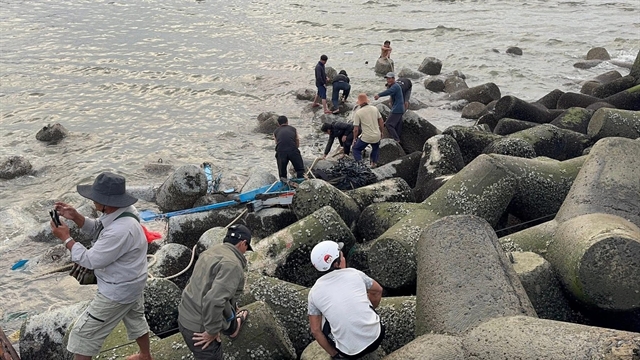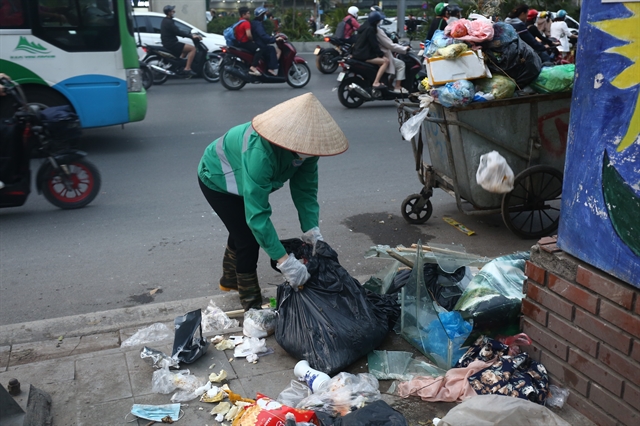 Environment
Environment


|
| Flood from upstream badly affected to people in northern mountainous province last year. — VNA/VNS Photo Quốc Khánh |
HÀ NỘI — The Central Steering Committee for Natural Disaster Prevention and Control has asked ministries, sectors and local governments to prepare for flooding as a result of heavy downpours in the northern region in the coming days.
Concerned agencies were told to conduct a comprehensive inspection of supplies, equipment and human resources to deal with natural disasters, as well as to carefully check the dyke systems in the region.
To respond to torrential rains in mountainous and delta regions, the committee’s deputy head Trần Quang Hoài requested the National Centre for Hydro-meteorological Forecasting to regularly provide weather updates with in-depth observations for the public.
The Irrigation General Department was asked to provide materials on natural disaster preparedness for the committee to execute natural disaster prevention work.
All fish-breeding cages have been moved out of the downstream of Hoà Bình Hydropower Reservoir and the Hoà Bình Hydropower Plant has set up plans for emergency discharge if necessary.
The Việt Nam Disaster Management Authority (under the Ministry of Agriculture and Rural Development) was tasked with preparing appropriate means and equipment for access to areas affected by flash floods and landslide.
The committee will work with the Ministry of Health and local governments to set up evacuation plans.
The Ministry of Industry and Commerce was told to give safety warnings about mineral exploitation in areas at high risk of landslides and mine collapses.
Local governments have to update the weather situation to the committee and the State Committee for Incidents and Disaster Response, and Search and Rescue.
Mai Văn Khiêm, director of the National Centre for Hydrometeorological Forecasting, said from June 25 to July 1, the water levels in hydro-meteorological stations in China tended to change slowly as they were affected by upstream hydropower reservoirs.
There were no floods and the daily average rainfall was 10-30mm, he said.
Meanwhile, water levels in the Hồng (Red) and Thái Bình rivers in northern Việt Nam remain low and changing slowly.
“In the past, major floods originated from China’s Yuanshui River to Việt Nam caused unusual floods in the Đà and Thao river in the years of 2008, 2015 and 2018,” said Khiêm.
However, the flooding in Việt Nam territory was weakened due to widening river mouths so they could not make devastating floods in the Red River Delta, he said.
Major floods in the Red and Thái Bình river basins were formed due to a combination of various weather patterns causing heavy rains such as storms, low-pressure systems and tropical convergence strips.
The flood flow from China did not contribute much to big floods in the Red River basin but it would increase the complexity of floods on high floodplains, Khiêm explained.
Meanwhile, deputy director of Agricultural Department of the Government Office Đào Quang Tuynh said Prime Minister Nguyễn Xuân Phúc had paid attention to the flood and rain situation in China.
The Việt Nam Meteorological and Hydrological Administration is responsible for making statistics to define the correlation between floods in China and Việt Nam, Tuynh said.
The administration should foresee the worst scenario and propose plans responding to superstorms, incidents involving reservoirs and threats to dykes to ensure safety for people, he said.
The Ministry of Agriculture and Rural Development has responsibility for reviewing safety measures and responding to flash floods and landslides in riverbank areas.
Nguyễn Hữu Hùng, an official of the State Committee for Incidents and Disaster Response, and Search and Rescue, said the army and police must work with localities to carry out evacuations in urgent cases.
According to Lê Minh Nhật, deputy director of Natural Disaster Response and Recovery, since earlier this year, several extreme weather phenomena occurred in the northern mountainous areas such as thunderstorms, whirlwinds, lightning and hail which killed 19 people and damaged 56,908 houses and several hectares of crops.
There have been high risks of flash floods, landslides, danger to hydropower reservoirs, irrigation and dyke systems in mountainous provinces, said Nhật.
July forecast
According to the National Centre for Hydrometeorological Forecasting, hot weather will continue scorching the northern and central regions this month.
Temperatures will be 0.5-1 degree higher than the same period last year at 36-38 degrees Celcius.
In the early days this month, northern provinces will have rains and heavy rains with thunderstorms so it is necessary to prepare for whirlwinds, lightning, flood and landslides.
At the end of July, there is likely to be tropical depressions and storms in the East Sea. — VNS




